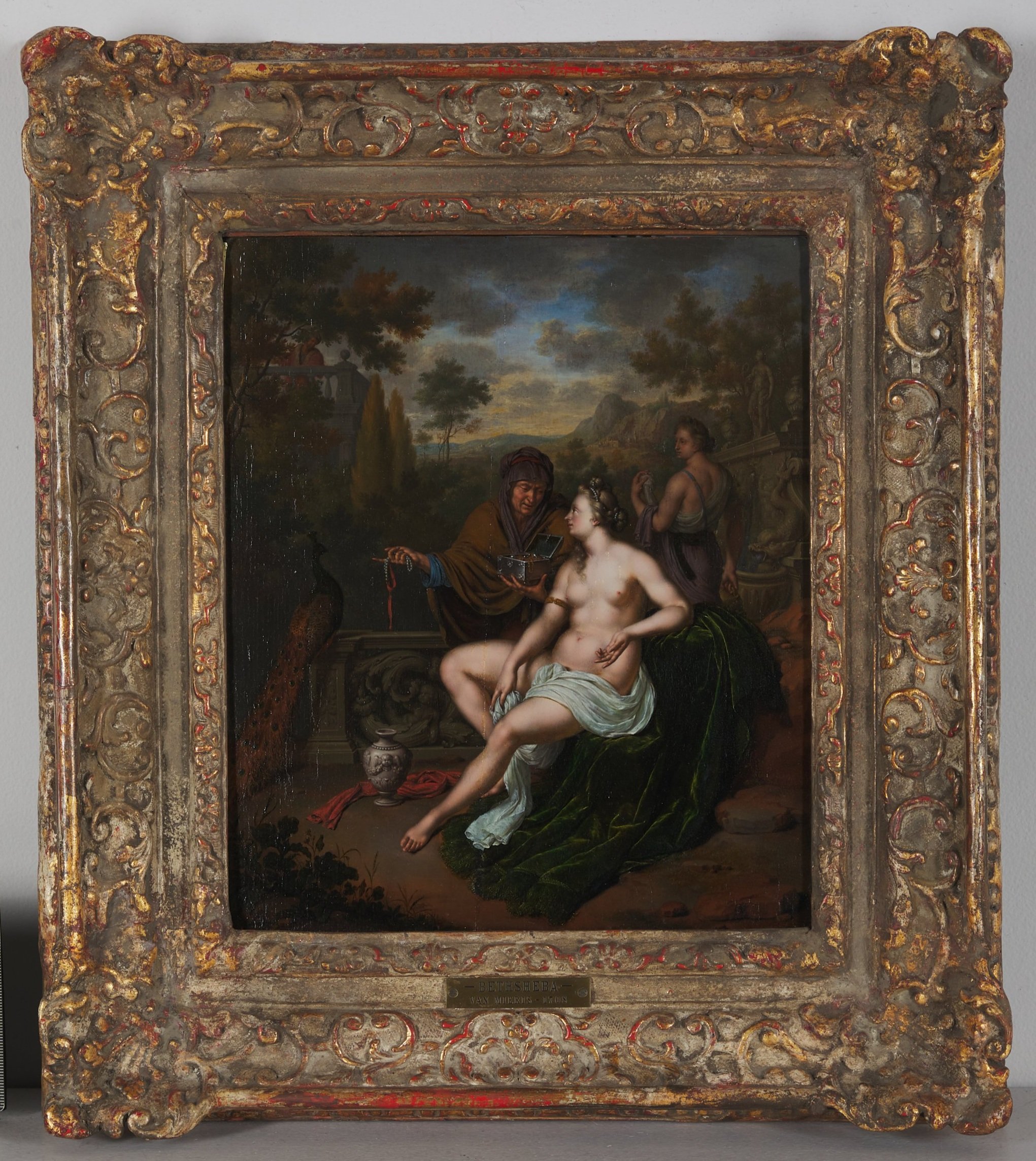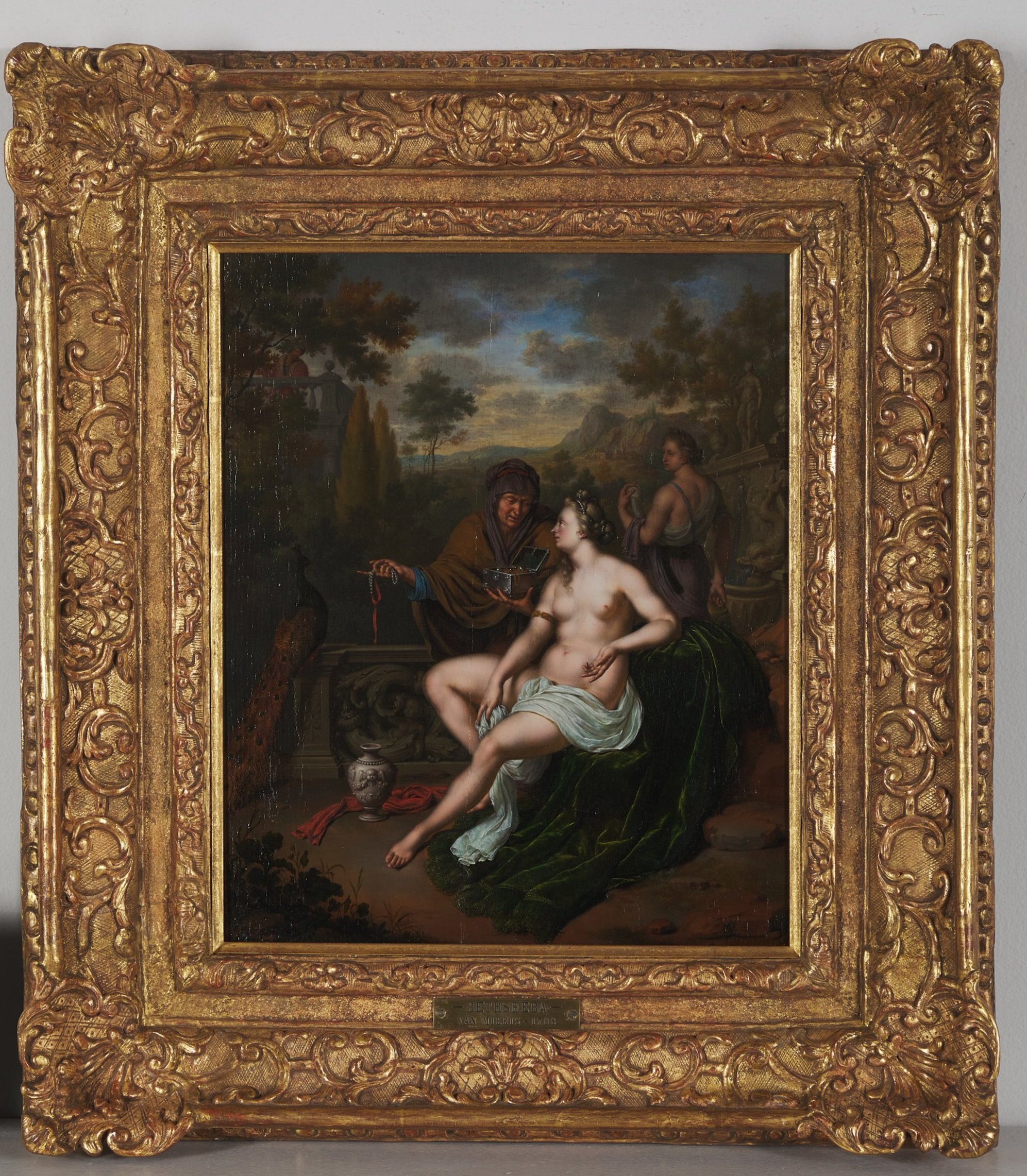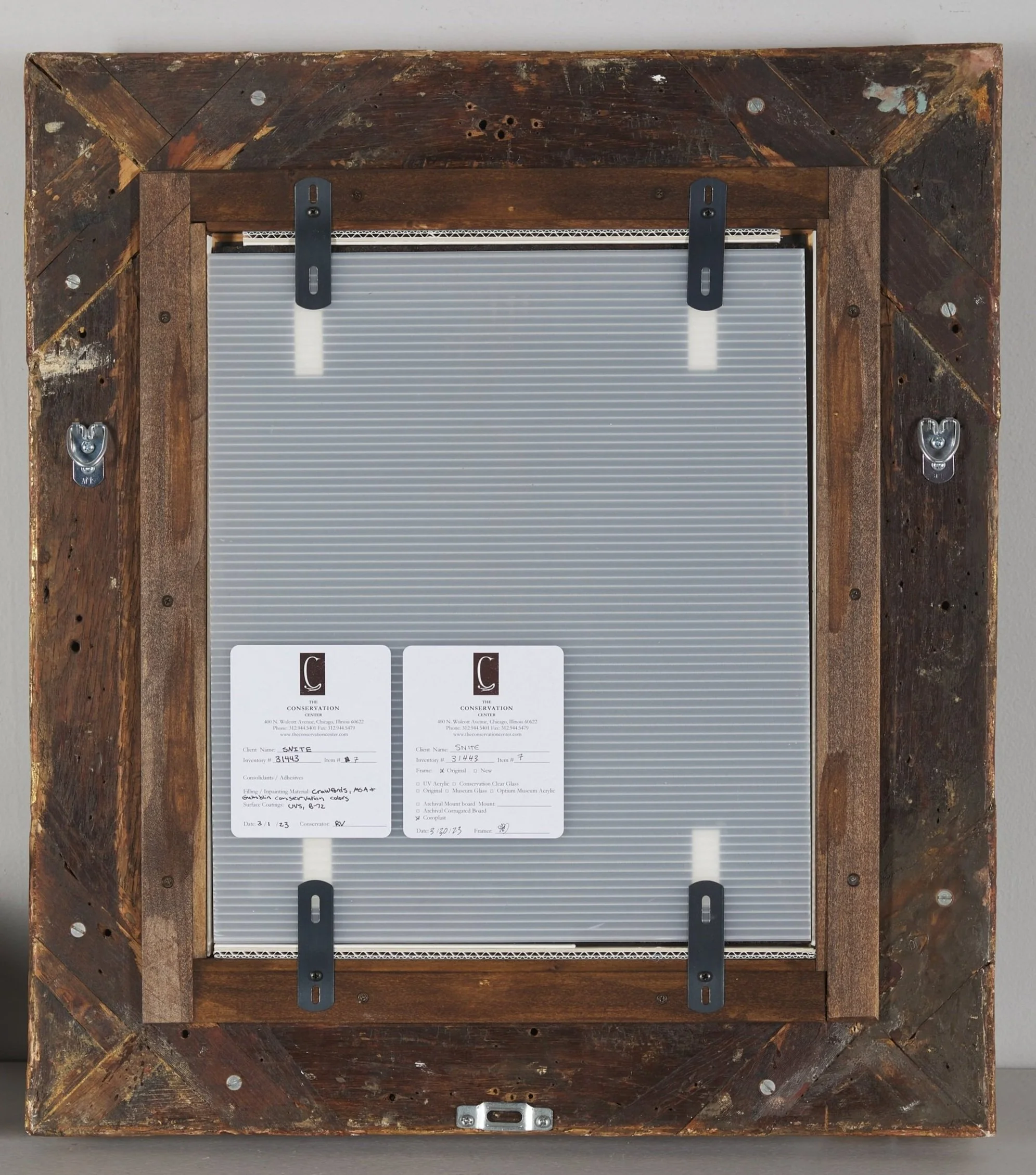Every year, The Center receives thousands of items of all kinds, yet some truly stand out. Bathsheba (1708) by Willem van Mieris arrived at The Center from the art collection at Notre Dame University, Indiana. As construction progresses on Notre Dame's new Raclin Murphy Museum of Art, The Conservation Center has been busy conserving select pieces from the collection. These artworks will be displayed in the new facility, set to open in November 2023. Preserving artwork is always an honor, but parting with this one was bittersweet. Our CEO, Heather Becker, even shared, "I was sad to see it go."
Bathsheba (1708) by Willem van Mieris, before treatment
Bathsheba (1708) by Willem van Mieris, verso before treatment
Willem van Mieris (1662 - 1747) was from a Dutch family of artists. Like his father, Frans van Mieris the Elder, Willem van Mieris was a part of the Fijnschilders painters known for their incredibly fine-detailed and meticulous painting style of diminutive scale works. Bathsheba (1708) is 14 5/8 by 12 3/8 inches but is dense with details. Associate Paintings Conservator Rebecca Vodehnal had the pleasure of treating Bathsheba (1708), and her thoughts echo this: "It was a lovely painting to treat. The level of detail on it, from the peacock to the pearls, was incredible."
Bathsheba (1708) by Willem van Mieris, before treatment detail
Treatment began with carefully assessing the condition of the painting. The painting is on a wooden panel with a vertical wood grain, and there was an old crack at the left of the center that had been repaired. The crack ran the length of the painting but was wider as it approached the bottom. The crack had been filled and inpainted. The panel was structurally stable, but the previous inpainting had discolored over time and no longer matched the original paint layer. Additionally, there were small scattered discreet dots of retouching in the sky. The varnish layer was still clear and stable but would be removed to address the discolored inpainting.
Bathsheba (1708) by Willem van Mieris, during treatment under UV light
Bathsheba (1708) by Willem van Mieris, during treatment
Rebecca began treatment of the painting by surface cleaning to remove any grime using aqueous solutions determined safe after testing. The varnish layer was then removed with appropriate solvents, removing the previously applied inpainting as well. Small areas of loss were filled using conservation-grade fill materials. An isolating brush varnish layer was then applied to act as a barrier between the original paint layer and the new inpainting that Rebecca then carried out in the areas of fills using reversible conservation paints. Noting the exquisite detail of the painting, Rebecca shared, "That level of detail and refinement made inpainting challenging." A final coat of spray varnish was then applied to integrate the surface gloss of the painting.
Bathsheba (1708) by Willem van Mieris, during treatment, detail
Bathsheba (1708) by Willem van Mieris, during treatment showing repaint removal
Bathsheba (1708) arrived at The Center housed in a Louis XIV period frame. However, the detail and original handwork of the frame had been obscured by many generations of restoration. Senior Conservator of Objects and Frames Josh McCauley examined the frame upon arrival at The Center and assessed its condition. "There was a very thick coating of red bole over poor fills that had been gilded with imitation gold leaf. A final layer of matte paint washes has then been applied over the gilding. Those applied layers covered the detailed gesso work." The frame size had also been altered in the past, and the panel was not fully engaged with the top lip of the frame.
Josh began treatment by removing the previous coatings and repairs, including epoxy, filler, overpaint, imitation gold leaf, and plaster repairs. Josh noted, "The gesso recutting adds extra refinement to the carvings, such as crosshatching, punchwork, and veins in the carvings. I was able to remove the restorations revealing the original hand work in the gesso layer and was able to expose and retain the original gilding." The miter joints were stabilized with balsa wood shims attached with conservation adhesives. The surface was consolidated, and the corner ornament losses were filled with Jelutong wood adhered in place with conservation adhesives, which were then carved to match the original ornament.
Louis XIV period frame during treatment, showing fills
Gesso losses were filled with traditional gesso that was toned with bole that was matched to the original. Josh then water-gilded the gesso fills with 23-karat gold that was toned to match the original gilded surface, and more minor abrasions were toned with mica powders and pigments. To ensure a better fit for the painting, a custom-made gilt fillet was added to the frame to ensure the panel would be fully engaged in the frame. Josh shared that "the treatment saved a quality period frame that can now be enjoyed for future generations."
With the treatment of both items complete, the Custom Framing and Display Department began the reframing process. Associate Conservation Framer Suz Evans noted that the clips on the back of the frame were peculiar but designed specifically for this panel painting, as panels are known to move and warp over time in response to temperature and humidity changes. As a result, Suz shared, "I added acid-free matboard shims to distribute the pressure from the clips evenly. The clips follow the vertical wood grain of the panel so as not to strain the curved shape of the wood further; this is why the clips are only installed on the top and bottom of the frame." Senior Conservation Framer Scott Dietrich performed the final assembly of Bathsheba into the frame.
Bathsheba (1708) by Willem van Mieris after treatment
Willem van Mieris's exceptional artistry, the delicate painting conservation work of Rebecca Vodehnal, and the meticulous frame conservation by Josh McCauley all come together in the expert reframing work by Scott Dietrich and Suz Evans. This collective effort ensures that Bathsheba (1708) stands as a testament to fine art and a treasured masterpiece destined to be admired by both present and future generations at the Raclin Murphy Museum of Art.
Bathsheba (1708) by Willem van Mieris after treatment
Bathsheba (1708) by Willem van Mieris, verso after treatment















